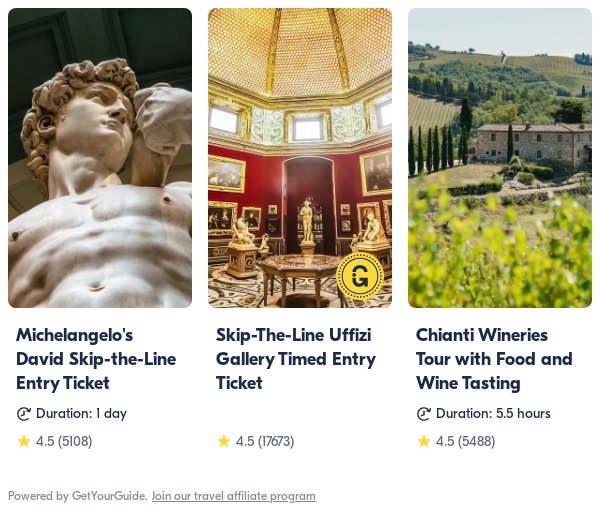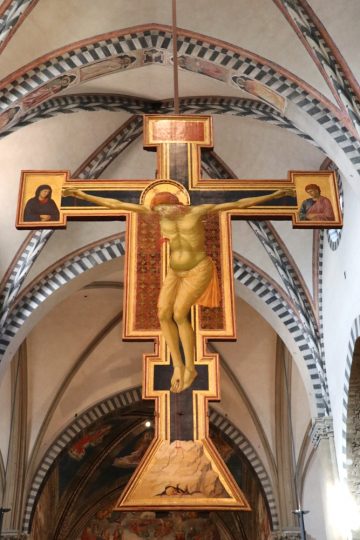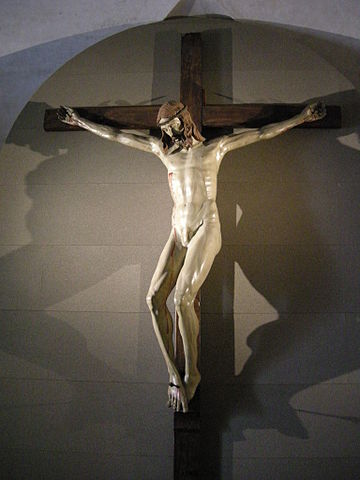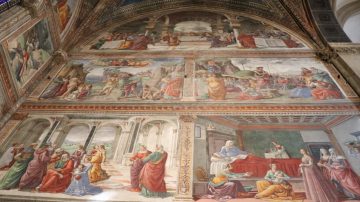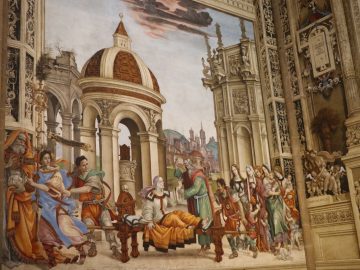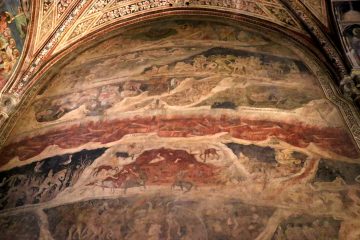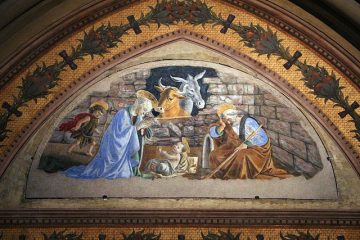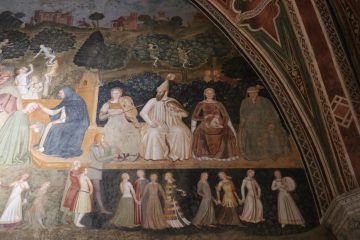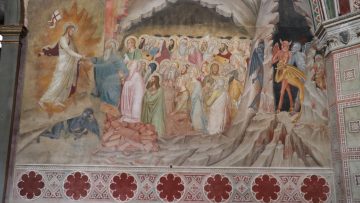Santa Maria Novella has some of the finest medieval and Renaissance art in Florence, including Masaccio’s Holy Trinity and a Crucifix by Giotto.
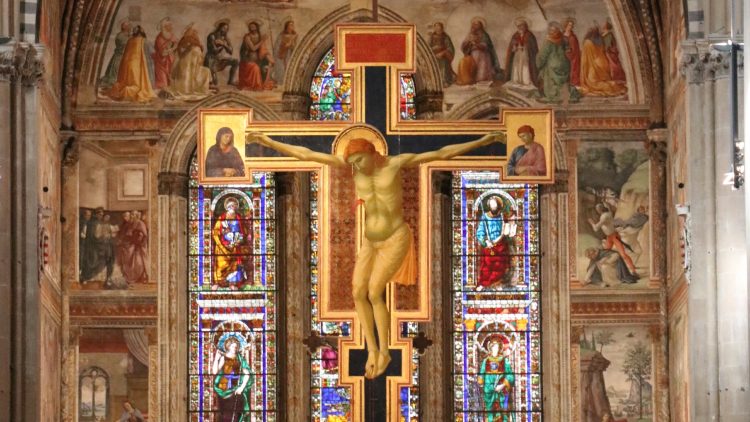
The Basilica of Santa Maria Novella, originally a Dominican monastery church, has always been full of art. Top works include Masaccio’s Holy Trinity — an early application of the rules of perspective — and a huge crucifix by Giotto. The church is particularly known for its fine frescoes including 14th-century frescoes inspired by Dante, as well as late-15th-century works by Ghirlandaio and Filipino Lippi. Don’t miss the 14th-century frescoes in the adjacent cloisters and Spanish chapel. Although many of the best works are now elsewhere, especially in the Uffizi and Accademia, many fine works remain here including items by Brunelleschi, Botticelli, Ghiberti, and perhaps Michelangelo. See also Visit the Santa Maria Novella Church in Florence for more details on the basilica and museum.
→ Top museums, churches, and sights in Florence are open mostly as normal in 2024 — see 2024: Florence Opening Hours of Top Sights, Museums, and Churches for the latest information and opening hours. The Firenzecard is again sold while the Turbopass Florence City Pass is a good alternative that includes online timeslot reservations for both the Uffizi and Accademia.
The Holy Trinity by Masaccio
The church of Santa Maria Novello in Florence lost many frescoes when chapels were added in the 16th century to the nave. However, these contributed to the preservation of one of the most celebrated artworks in the church — the Holy Trinity (1425-26) by Masaccio. It was rediscovered, in very good condition, hidden behind a chapel altar during renovations in the 19th century.
This Holy Trinity is considered one of the earliest works to apply correctly the rules of perspective to painting. It shows the Holy Trinity – God as Father, Holy Spirit (dove) and Son — in a crucifixion scene set under a Roman triumphal arch. The disciple John looks up at Christ while Mary, portrayed realistically as an older woman, looks out at the viewer. The painting is flanked by members of the sponsor family (Lenzi).
The cadaver tomb painting at the bottom is also by Masaccio and was only rediscovered in situ in the mid-20th century. It message — “What you are, I once was; what I am, you will become” — was a warning to live a God-fearing life but also, given the crucifixion scene above, for the religious a promise of salvation in the life after death.
There are many further tombs and paintings in the nave, which in other locations might have been popular attractions but in Florence, a higher standard is required to attract much attention. The better art is in and near the transept.
Crucifixes by Giotto and Brunelleschi in Santa Maria Novella
The art inside the Santa Maria Novella basilica has endless crucifixion scenes but in addition to Masaccio’s painting, two further ones are of particular note:
High in the center of the nave near the apse is a large painted crucifix by Giotto. It is an early work from around 1280 and thus the oldest major artwork in the church. Christ on the cross is flanked by portraits of the Virgin and John the Evangelist on each end of the crossbar. This tempura and gold painting on wood measures a considerable 578 x 406 cm.
Throughout history, Giotto’s Crucifix was placed in various places inside the church and sacristy. The rear is plain indicating that it was never intended to hang as centrally is it now.
In the surprisingly restrained Gondi Chapel (to the left of the main Tornabuoni Chapel), is a wooden Crucifix by Brunelleschi.
He rarely worked in this genre but according to Vasari, Brunelleschi was enraged when he saw Donatello’s Crucifix in Santa Croce and called it a peasant on the cross. Donatello challenged him to do better and as a consequence, Brunelleschi carved this idealized Christ inspired by Giotto but with the body twisted and in perfect perspective and correct proportions. According to legend, Donatello dropped the eggs he was carrying when he saw the sculpture the first time. (Some of the finest works by Donatello is in the Bargello Museum in Florence.)
Although the formal challenge almost certainly never occurred — Brunelleschi’s work was made only several years after Donatello’s — it was not a special commission and was still in his studio at the time of his death.
The pulpit in the church was also designed by Brunelleschi but is mostly significant as the first place from where Galileo Galilei was attacked by the church. Brunelleschi’s work in San Lorenzo, and of course the cupola of the Duomo, are far more impressive.
Frescoes in the Chapels of Santa Maria Novella
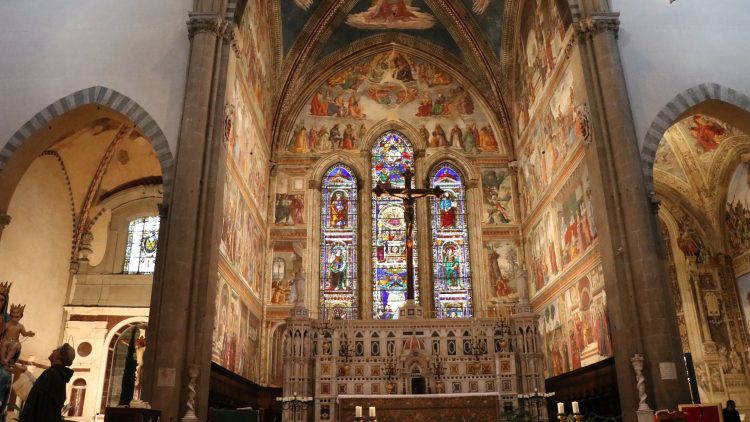
The various chapels in the transept are filled with art but the most impressive are certainly the frescoes of the Torbanuoni Chapel in the chancel with the main altar, the Filippo Strozzi Chapel to its right, and the Cappella Strozzi di Mantova chapel on the far left. The stained-glass windows here are mostly the originals designed by the same artists that decorated the chapels.
Tornabuoni Chapel
The Tornabuoni Chapel is in the chancel of the basilica with the main altar. It is named after the Tornabuoni family who bought the rights to it off the Ricci family that failed to recover from bankruptcy.
The frescoes here were painted by Domenico Ghirlandaio from 1485 to 1490. They feature mostly scenes from the life of the Virgin (left wall), St John the Baptist (right wall), and various Dominican saints (rear wall). The frescoes are particularly valued for showing characters in typical Florentine dress of the late 15th century.
Ghirlandaio also designed the windows while the original altarpiece is now held divided between the Gemäldegalerie in Berlin and the Alte Pinakothek in Munich. The current Neo-Gothic main altar is by Enrico Romoli who directed the restoration of the church in 1860.
Michelangelo was an apprentice of Ghirlandaio. According to legend, the 14-year-old Michelangelo “corrected” some of his masters drawing for these frescoes before being chased off. He might also have assisted in the painting of the Martyrdom of St Catherine by Giuliano Bugiardini in the Rucellai Chapel. Michelangelo’s main works in Florence are David in the Accademia and the Medici Chapels.
Filippo Strozzi Chapel
The Filippo Strozzi Chapel, immediately to the right of the Tourbabuoni Chapel, were decorated by the celebrated Renaissance painter Filipino Lippi. Work started around the same time as the Tornabuoni frescoes but the decorations were only completed in 1503 — more than a decade after Strozzi’s death.
The frescoes depict scenes from the lives of John the Evangelist and the Apostle Philip. The main frescoes of St John include martyrdom — surviving being boiled in oil — and the resurrection of Druisana. The frescoes of Philip include driving out a rather small dragon from the temple of Hieropolis and his martyr death by crucifixion.
Cappella Strozzi di Mantova
The frescoes in the Cappella Strozzi di Mantova — far left — are much older and in a worse state of preservation than those of the Strozzi and Tournabuoni chapels. They are mostly by Nardo di Cione and painted around 1360. The frescoes were inspired by Dante’s Divine Comedy with hell and purgatory on the right wall and paradise on the left. The back wall features the Last Judgment and includes a portrait of Dante.
The windows depict a Madonna and Child and St Thomas Aquinas — a leading Dominican. He is also depicted in the ceiling of this chapel and in the Spanish Chapel (off the cloisters).
Further Art in Santa Maria Novella
Although many of the best moveable pieces from Santa Maria Novella are now in the Uffizi or Accademia (in the religious art section that most visitors rush through after seeing David), several further works by famous artists are still on display inside the church and in the small adjacent museum:
In the transept is a half-circle lunette fresco of the Birth of Christ painted by Botticelli. His most celebrated work originally installed in this church — the Adoration of the Magi (1475) — is now with many of his finest paintings in the Uffizi.
In the Rucellai Chapel — the family that paid for the marble facade — is a Martyrdom of St Catherine by Giuliano Bugiardini (possibly with assistance from Michelangelo). The bronze tomb is by Lorenzo Ghiberti, who made the paradise doors of the baptistery at the Duomo.
Art in the Museum of Santa Maria Novella
More art is seen in the small museum and cloisters in the Santa Maria Novella monastery complex. Various frescoes and decorations survived in the four cloisters but the artistic highlight of the museum is the Spanish Chapel.
A variety of artworks from various parts of the complex are now displayed in the small museum. Arguably the best paintings here are two Last Suppers — one by Allesandro Allori and the second by the nun Plautilla Nelli. The latter, measuring 7 by 2 m, was recently restored and on display since late 2019.
Inside the Green Cloisters are a few frescoes from the early 15th-century depicting scenes from the Book of Genesis. The best-known scenes are the well preserved Original Sin and Great Flood by Paolo Uccello.
In the Great Cloisters are frescoes painted by at least 15 Florentine artists during the late 16th century.
Frescoes in the Spanish Chapel
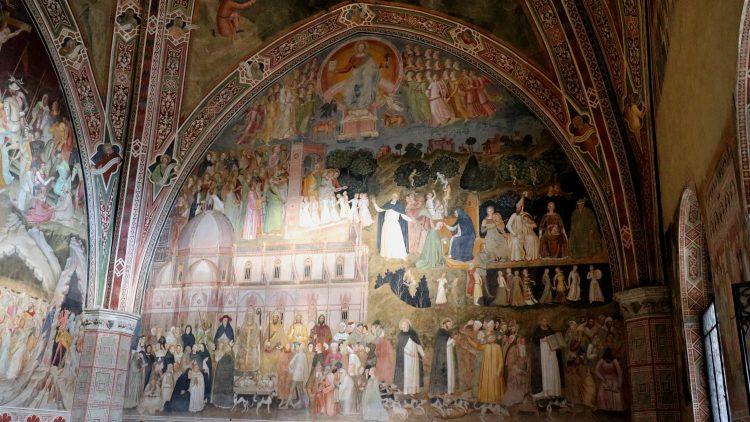
The walls of the Spanish Chapel, off the Green Cloister, are decorated by frescoes painted in 1365-67 by Andrea di Bonaiuto. These frescoes have magnificent details in for example the clothing, decorations on buildings, animals, and vegetation.
The most impressive painting is the Allegory of the Active and Triumphant Church and of the Dominican order, or La Via Veritas. It shows the triumph of the Roman Catholic Church over heresy. It also features many famous people including Dante, Beatrice, Giotto, Cimabue, as well as the pope and emperor.
The bottom row right shows Dominican friars preaching and persuading the heathen to accept the true faith. St Thomas Aquinas shows the heretics the true word (open book). Above him are various sins and temptations. The row of dancers is obvious but for the modern viewer some of the other allegories are harder to read: the three next to the violinist represent respectively pride, lust, and avarice. Note the people in the trees above — not so much sinning by stealing than literally picking forbidden fruit.
To the left of the violinist, a Dominican priest takes confessions and a further priest points the way to the doors of heaven and salvation.
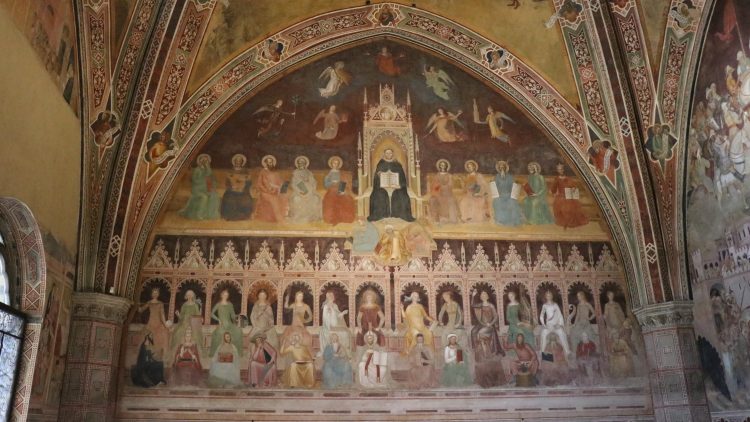
The Triumph of St Thomas Aquinas and the Allegory of Christian Learning shows the famous and learned Dominican saint flanked by virtues and a variety of academic disciplines — the Dominican order and Santa Maria Novello were famous for scholastic endeavors.
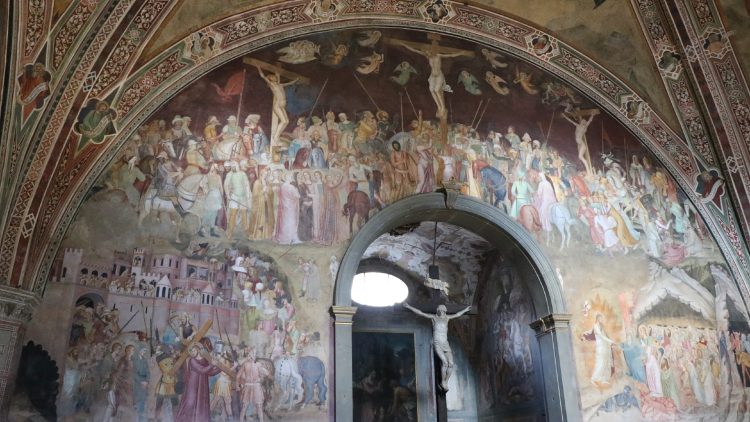
On the archway wall is a large Crucifixion with the Way to Calvary and the Descent into Limbo. Christ bursting into hell by smashing down a vault-like door is a popular image in late medieval and Renaissance art. One of the cells in the Museum of San Marco has a similarly painted devil trapped under the door image painted by Fra Angelico.
See Visiting the Santa Maria Novella Church and Museum for more details on the history and architecture of this remarkable complex, as well as practical information on visiting the basilica.
More Articles on Florence Sights
The high season in Florence is increasingly long: Easter, May, July, August, and the Christmas holidays are especially busy. November and January to mid-March are the only quiet months. Plan and book time-slot reservation tickets and tours when available in advance — the Accademia and the Uffizi are again sold out weeks in advance. Top sights are quieter directly at opening time or in the late afternoon.
→ → Special opening hours for top sights in 2024 — most sights are open normal hours in 2024 but advance time-slot reservations when available are always sensible even for sights where bookings are optional.
- Tips on Buying Tickets for the Uffizi Museum
- Tips on Buying Skip-the-Line Tickets for the Accademia (Michelangelo’s David)
- See Michelangelo’s David in the Galleria dell’ Accademia
- Visit the Duomo sights: Cathedral (Duomo), Baptistery (Battistero), Bell Tower (Campanile), Dome (Cupola), Museum (Museo), and Tickets + Opening Hours
- Visit the Bargello Museum of Sculpture (Donatello’s Davids)
- Visit San Marco Museum to see the frescoes and altarpieces painted by Fra Angelico.
- Visit Santa Maria Novella Church and Museum to see medieval and Renaissance Art.
- Visit Santa Croce for Giotto Frescoes and Michelangelo’s Grave
- San Lorenzo complex: Visit the Basilica for Renaissance Art, See the Laurentian Medici Library by Michelangelo, and Visit the Medici Chapels (Michelangelo Statues)
- Save on Sightseeing in Florence with the Firenze Card (again available but not including transportation or the Duomo sights, or consider the Turbopass Florence City Pass that includes online timeslot reservations for both the Uffizi and Accademia.
- Travel to Pisa to see the Field of Miracles and the Leaning Tower of Pisa.
- Visit the magnificent Romanesque-Gothic cathedral in nearby Siena.
- Save on top Italian designer fashion at The Mall Factory Outlet Stores.
Florence Resources
- The official Firenze Tourist Office website is a bit cumbersome but has very useful information. Especially the pdf (alternative link) with the opening hours of all major sights. Unfortunately, it is only available for the current month but it is the second last line on opening hours — the final say is the guard at the door, NOT the ticket window!
- Get Your Guide offers tours of all major sights while Tiqets sells online tickets for many top sights in Florence.
- Book luggage storage online and explore Florence more easily on foot.
- Trainline is good for booking online train tickets in Italy and most of Europe.

